1st to 12th October was spent on my favourite island archipelago, the Isles of Scilly. I was very lucky that my parents had a four bedroom cottage and with my sister already booked in there was still a spare room for me to use.
On Friday 30th I spent a rather uncomfortable night on the 'night riviera' the sleeper train from Paddington to Penzance. I arrived around 45 mins late and just made the connection to the scillonian, but I did make it!
The rather rocky boat trip yielded a couple of
puffins, bonxie, 3 storm petrel, 10 manx shearwaters and best of all a
great shearwater.
The first day on the Isles we located a rather odd looking wheatear amongst the obvious Northerns, it looked quite different to the others in colouration, posture and even size. As it was getting dark very soon we decided to put news out of an interesting looking wheatear sp, sure enough the locals soon turned up, but proclaimed that it was an oiled northern, oh well, at least people got to see it rather before it got dark...lesson learnt (I've done this before with a very wet wheatear! good job I went to BO dunes this weekend to see some rare wheatears). I have included the pics here as it was quite an odd looking bird, certainly stood out amongst the others!
 |
Oiled wheatear, you can hopefully see why we started to get a little excited about this
one in the fading light, certainly did look different to us at the time, oh well, next time! |
Peacehaven cottage, located at Watermill cove gave us a great location for birding and mothing.
I was out at dawn every day and back not long before dusk most days, giving around 10 hours of birding a day, so by the end of the trip I was pretty shattered! My pre breakfast circuit included Newford duck pond and watermill cove, sometimes further to Trenoweth and Helvier, a very nice and sometimes productive morning walk.
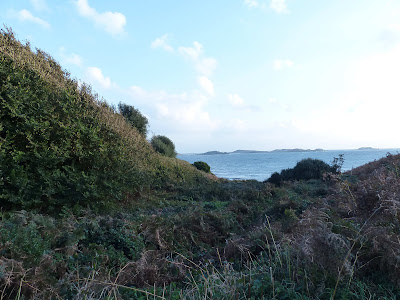 |
| Watermill cove, our cottage was behind the scrub on the left |
On one particular morning walk a very ferocious looking storm approached, the lower picture shows a distant cloud with three waterspouts appearing from it, they did look a lot more impressive in real life and kept on changing in number and length. None ever actually touched down so probably not technically waterspouts, but impressive formations. Then all of a sudden just in front of me the clouds started circling and dropping quickly, unfortunately it soon came over the land and dissipated, but was quite exciting to witness.
The highlights are as follows, it was a really great 12 days of birding, much like it used to be when I was younger (my last trip 5yrs ago yielded wryneck and rb fly as the best birds of the trip) this year was far better.
Sora- lifer
Red-eyed vireo- lifer and a bit of a bogey bird, which I have managed to miss by a day or so on many occasions, one such trip 3 turned up within 3 hours of me leaving the Isles!
Blyths pipit (thanks Will/spider for pinning it down the evening before)
Caspian tern
Subalpine warbler (sp)
American golden plover
Buff breasted sandpiper
Red-backed shrike
Grey Phalarope-
Whinchats- many across the isles well over 40
Short-toed lark
Firecrest-7
Jack snipe-15+
Snow bunting
Lapland bunting -6
Cattle egret-2
Little bunting-1
Red breasted flycatcher- 2 self found
Wryneck-5, I think 2 were self found, possibly 3.
Yellow-browed warbler- 50+ these beauties were everywhere!
Redstarts
Black redstarts
pied flycatchers
spotted flycatchers
So while it doesn't quite match up to Shetlands 12 days of megas, it was quite enough to keep us occupied and the birds continued to arrive throughout the period giving us optimism!
 |
| AGP |
 |
| RBS |
 |
| Cattle egrets |
 |
| Black-necked grebe |
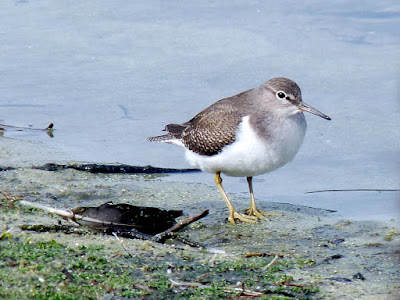 |
| Common sandpiper- always worth double checking these on Scilly |
 |
| Little Bunting |
 |
| Wryneck- flew in off right in front of us at Penninis |
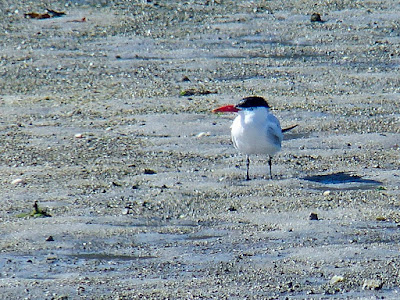 |
| The Isles first Caspian tern |
 |
| Incoming Firecrest |
 |
| Jack Snipe |
 |
| Subalp sp |
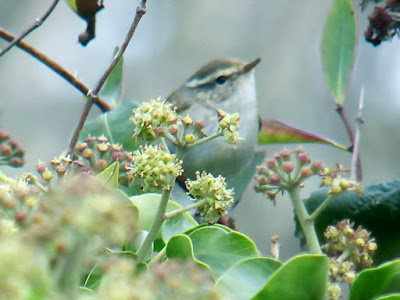 |
| When I first saw this dark cheek I thought I may be onto a winner, but 'just' a YBW' |
 |
| Red-eyed vireo |
 |
| Greenshank |
 |
| another Jack, little crackers! |
The moths were also very good, my father Chris, brought an MV and a heath trap and had a very good range of species throughout the stay. It was amazing to see the trap with 90% migrants inside and figures were not at all bad either with around 25-35 species a night in the traps.
The real moth trap is the flowering Ivy, this was new to me but it was obvious that in the first few hours of dark the Ivy was a hive of activity.
The best night on the Ivy was 7th October, when dadad I walked from Watermill down rocky hill to the lower moors and back, the results of this fantastic walk are below.
|
Crocidosema plebejana |
1 |
| 1395 Rusty Dot Pearl |
Udea ferrugalis |
125 |
| 1398 Rush Veneer |
Nomophila noctuella |
704+ |
|
Palpita vitrealis |
3 |
| 1524 Common plume |
Emmelina monodactyla |
23 |
| Angle Shades |
Phlogophora meticulosa |
8 |
| Black Rustic |
Aporophyla nigra |
3 |
| Brick |
Agrochola circellaris |
3 |
| Common Marbled Carpet |
Chloroclysta truncata |
5 |
| Cypress Carpet |
Thera cupressata |
1 |
| Dark Sword-grass |
Agrotis ipsilon |
6 |
| Double-striped Pug |
Gymnoscelis rufifasciata |
6 |
| Gem |
Orthonama obstipata |
2 |
| Herald |
Scoliopteryx libatrix |
1 |
| Large Yellow Underwing |
Noctua pronuba |
10 |
| Lunar Underwing |
Omphaloscelis lunosa |
5 |
| Pale Pinion |
Lithophane hepatica |
4 |
| Pearly Underwing |
Peridroma saucia |
3 |
| Red Underwing |
Catocala nupta |
1 |
| Scarce Bordered Straw |
Helicoverpa armigera |
3 |
| Silver Y |
Autographa gamma |
57 |
| Square-spot Rustic |
Xestia xanthographa |
37 |
| Turnip Moth |
Agrotis segetum |
8 |
| White-speck |
Mythimna unipuncta |
27 | | |
We did a longer route on 11th from the Garrison back to watermill and had 21 white speck, 12 silver y, 1 dark sward grass, 1 gem and a pearly underwing, amazing the difference in moths, not a single rush veneer after seeing at least 704 a few nights before...migration!
Some additions to the above list for the rest of the holiday are below. The Porters rustic, Clancys rustic and Deaths-heard hawkmoths were courtesy of Dave Grundy who was staying on St Agnes, the Golden twinspot was from a coupe of guys staying in Hugh Town, but I'm not sure of names (sorry!). The rest were all found by dad, Chris Lewis in the traps at Watermill, I was very pleased to hear that on my parents last day, in fact last hour on the islands they noticed a Deaths Head hawkmoth next to one of dads traps, so he can finally tick it as a moth he has caught.
| Epermenia chaerophyllella |
| Scrobipalpa costella |
| Lobesia littoralis |
| Pediasia contaminella |
| Eudonia angustea |
| Blair's Mocha | Cyclophora puppillaria |
| Blair's Shoulder-knot | Lithophane leautieri |
| Clancy's Rustic | Platyperigea kadenii |
| Convolvulus Hawk-moth | Agrius convolvuli |
| Cypress Pug | Eupithecia phoeniceata |
| Death's-head Hawk-moth | Acherontia atropos |
| Delicate | Mythimna vitellina |
| Dewick's Plusia | Macdunnoughia confusa |
| Garden Carpet | Xanthorhoe fluctuata |
| Golden Twin-spot | Chrysodeixis chalcites |
| Humming-bird Hawk-moth | Macroglossum stellatarum |
| L-album Wainscot | Mythimna l-album |
| Lesser Yellow Underwing | Noctua comes |
| Pale Mottled Willow | Paradrina clavipalpis |
| Pearly Underwing | Peridroma saucia |
| Pinion-streaked Snout | Schrankia costaestrigalis |
| Porter's Rustic | Proxenus hospes |
| Radford's Flame Shoulder | Ochropleura leucogaster |
| Scarce Bordered Straw | Helicoverpa armigera |
| Setaceous Hebrew Character | Xestia c-nigrum |
| Small Mottled Willow | Spodoptera exigua |
| Vestal | Rhodometra sacraria |
| Willow Beauty | Peribatodes rhomboidaria |
I make it 20 moth ticks, which is impressive seeing as the traps at Strumpshaw and in my garden are currently producing around 4-5 species in total! A total of 52 species in October is very good indeed.
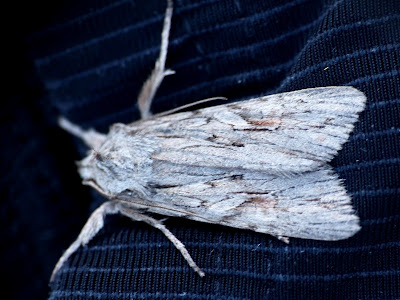 |
| Blairs shoulder knot- new for me |
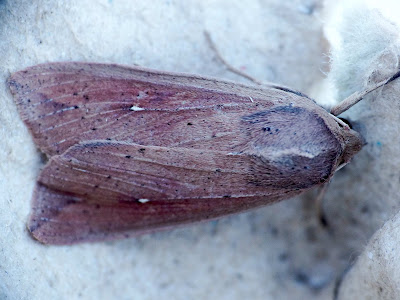 |
| White speck NFM |
 |
| Convovulous hawkmoth |
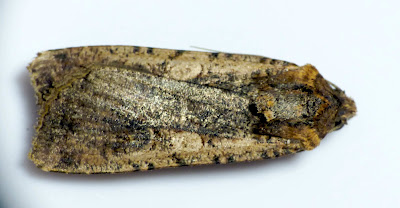 |
| Pearly underwing NFM |
 |
| Scarce bordered straw NFM |
 |
| Radfords flame shoulder NFM |
 |
| Porters Rustic NFM, thanks to Dave Grundy +co |
 |
| Deaths head NFM what a moth!! |
 |
| 3 Deaths heads, not a common sight in the UK! |
 |
| A rarer sight than even above- 3 Radfords flame shoulders! |
 |
| Vestal NFM, |
 |
| Golden twinspot |
 |
| Dewicks plusia |
| |
 |
| The Lewis family Scilly 'crew' 2016, Thanks guys I had a great time!! |
|
|
|
|
|
|
|
|
|
|
|
|
|
|
|
|
|
|
|
|
|
|
|
|
|
|
|
|
|
|
|
|
|
|
|
|
|
|
|
|
|
|
|
|
|
|
|
|
|
|
|
|
|
|
| | |

















































